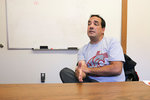

The current freshmen class at Centralia High School will need to earn more credits in order to graduate after the Washington State Board of Education changed the credit requirement to 24, which will lead to longer days during their senior year and a switch to a trimester system.
Prior to the change, high school students at Centralia High School needed 22 credits to graduate.
The change at the state level was first implemented for the class of 2019, but districts were allowed to apply for a two-year waiver to delay the requirements as changes were implemented.
“We, along with just about everyone else in the state, executed that waiver,” Centralia High School Principal Josue Lowe said.
In May, the Centralia School District Board of Directors adopted new graduation requirements setting the needed credit limit at 25 for the class of 2021. The credit number will increase to 28 for the class of 2022, 30.5 credits for the class of 2023 and will then go to 33 credits for the classes of 2024 and beyond.
The school district’s requirements surpass what the state mandates because the credits have to be proportional to the system that was designed and put into place, Lowe said.
“Our local graduation requirements had to be a product of the system changes we made to trimesters,” Lowe said. “If we left it at just the state requirements, our kids could earn 36 credits in four years, and they’d only need 24 to graduate. They would be done after their junior year, and that’s not what we wanted.”
The class of 2021 will see no changes until their senior year, when the opportunity to earn more credits will be available.
“We knew the underlying philosophy was to expand offerings to kids,” Lowe said. “We are going to stay with a six-period day, we are going to expand the amount of minutes in each period and then we are going to reduce the total number of days in a time period to earn a credit. Now, instead of 90 days to earn half a credit, you earn it in 60 days, but you have an increased amount of time in each one of those periods.”
A trimester system will be implemented in the fall of 2020, which will allow the students the opportunity to earn nine credits over the course of the year, or three credits each trimester. Currently, the semester schedule allows students to earn six credits.
“So this year’s freshmen will actually have the capacity to earn 27 credits,” Lowe explained. “Eighteen in their first three years and nine in the last year.”
Starting in the fall of 2020, class time within periods will increase from a 50-minute schedule to 60 minutes.
To help extend the learning time, study hall will be eliminated and there is an added capacity within the school day to add more minutes to classes, Lowe said.
Once the high school is remodeled and is designed in a more efficient manner, the breaks between periods will likely be shortened. The remodel of the high school will be completed in fall of 2020 after voters approved a $74 million bond, which will also construct two new elementary schools to replace Fords Prairie and Jefferson-Lincoln.
The change to include more credit requirements expands the offerings students will have available. The high school has already added more college in the high school offerings from three universities that allow students to obtain college credits. More advanced placement classes will also be offered, with a push to allow students to take the classes sooner than their junior and senior years.
“It will be a culminating event in the fall of 2020 when we have a physical space to match the programs we are developing,” Lowe said.
The change to the required credits at the state level included the addition of one more career and technical education credit, increasing the number to two. It also increased the amount of foreign language credits from zero to two and added one additional credit in the arts.
The additional world language and arts credits can be substituted out to match a student's personalized pathway requirements in their high school and beyond plan to prepare them to meet specific post-secondary career or educational goals.
“There are essentially three flex credits,” Lowe said, adding that if a student had no interest in taking the two credits in world language, then those credits could be utilized to meet the student’s personalized pathway requirements.
“Students working with their personalized pathway can say I’m really interested in metals, and so instead of taking two credits of foreign language, they can take beginning metals, intermediary metals, advanced metals and creative metals and meet the extra requirements in that way,” he said.
The process to make the changes that will hit in the fall of 2020 has been underway for three years, according to Lowe. Overall, he believes it will provide a more complete program for the high school’s students and will provide classes that meet their individual needs.
“Students that want to be challenged and want a rigorous education in preparation for either a career or to move right into a four year university can attain that here within our school building,” Lowe said. “They don’t have to go down the street to Centralia College to try to get that. That’s always been our purpose — what can we bring into our four walls, if you will, to prepare students more fully for the experiences they have beyond high school.”
The school board unanimously approved the changes, although school board member Jami Lund tried a number of amendments that were ultimately unsuccessful. The seven proposed amendments included adding a personal financial literacy credit and computer literacy coursework.